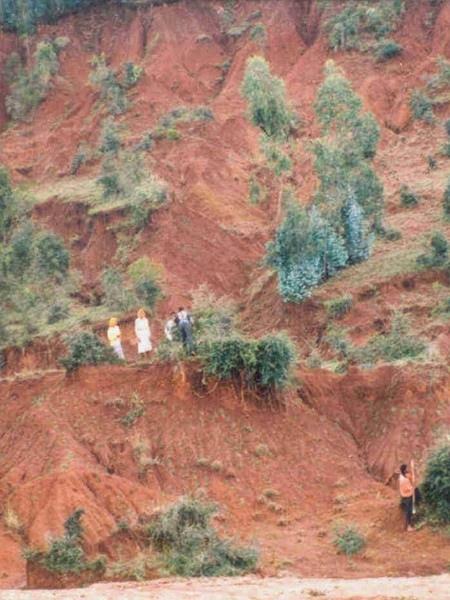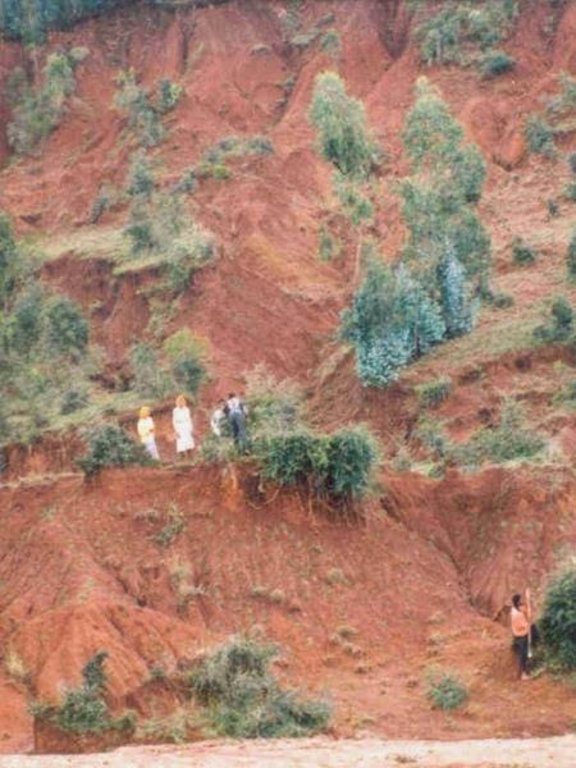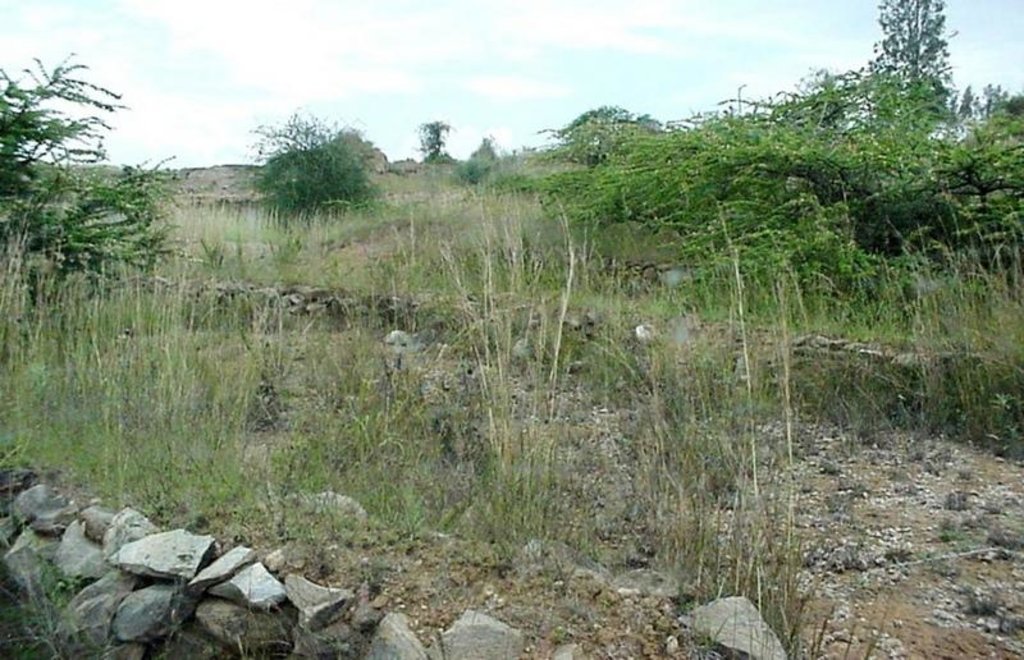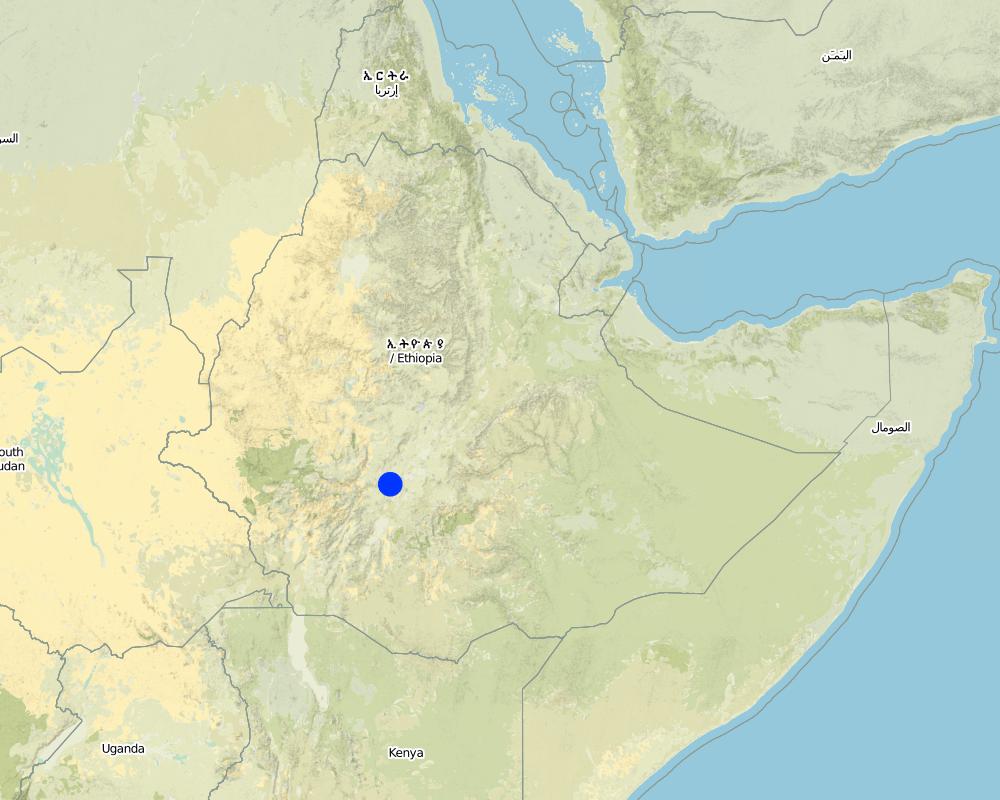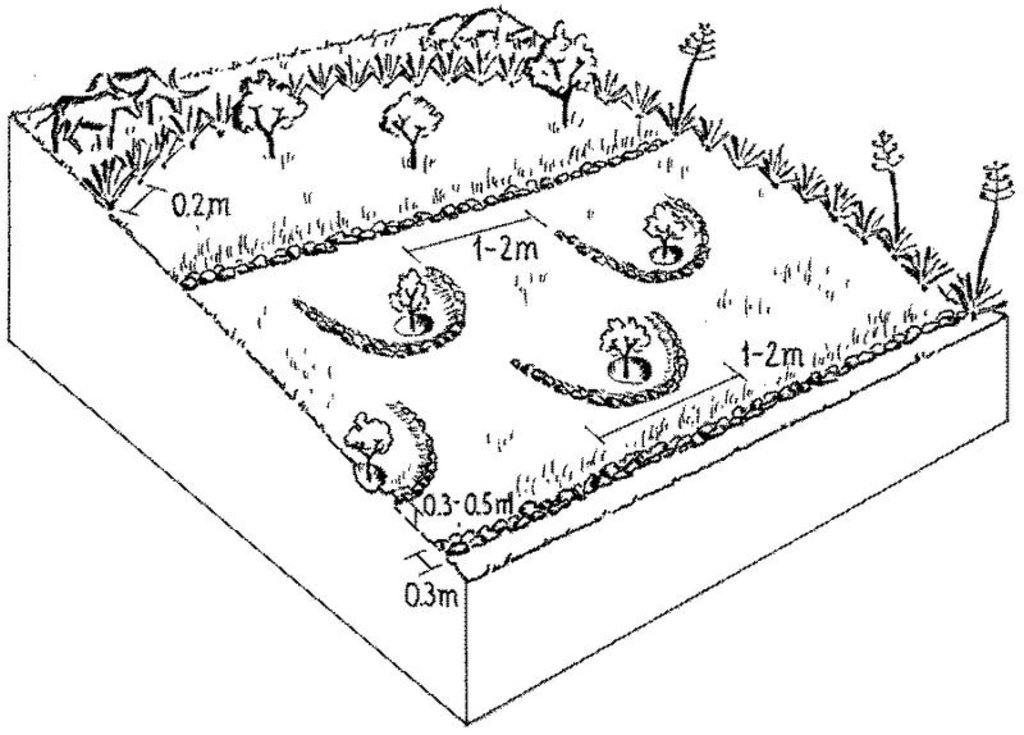Area closure for rehabilitation [أثيوبيا]
- تاريخ الإنشاء:
- تحديث:
- جامع المعلومات: Daniel Danano
- المحرر: –
- المراجعون: Donia Mühlematter, Fabian Ottiger
Meret mekelel
technologies_1048 - أثيوبيا
عرض الأقسام
توسيع الكل طي الكل1. معلومات عامة
1.2 تفاصيل الاتصال بالأشخاص الرئيسيين لمصدر المعلومات والمؤسسات المشاركة في تقييم وتوثيق التقنية
اسم المشروع الذي سهّل توثيق/تقييم التقنية (إذا كان ذلك على صلة)
Book project: where the land is greener - Case Studies and Analysis of Soil and Water Conservation Initiatives Worldwide (where the land is greener)اسم المؤسسة (المؤسسات) التي سهلت توثيق/تقييم التقنية (إذا كان ذلك على صلة)
Ministry of Agriculture and Rural Development of Ethiopia (Ministry of Agriculture and Rural Development) - أثيوبيا1.3 الشروط المتعلقة باستخدام البيانات الموثقة من خلال WOCAT
متى تم تجميع البيانات (ميدانيا)؟:
01/07/2003
يوافق جامع المعلومات والشخص (لاشخاص) الرئيسي لمصدر المعلومات على الشروط المتعلقة باستخدام البيانات الموثقة من خلال WOCAT:
نعم
1.4 إعلان بشأن استدامة التقنية الموصوفة
هل التقنية الموصوفة هنا تمثل مشكلة فيما يتعلق بتدهور الأراضي، بحيث لا يمكن إعلانها تقنية مستدامة لإدارة الأراضي؟:
كلا
2. وصف تقنيةالإدارة المستدامي للأراضي
2.1 وصف مختصر للتقنية
تعريف التقنية:
Enclosing and protecting an area of degraded land from human use and animal interference, to permit natural rehabilitation, enhanced by additional vegetative and structural conservation measures.
2.2 وصف تفصيلي للتقنية
الوصف:
Area closure involves the protection and resting of severely degraded land to restore its productive capacity. There are two major types of area enclosures practised in Ethiopia: (1) the most common type involves closing of an area from livestock and people so that natural regeneration of the vegetation can take place; (2) the second option comprises closing off degraded land while simultaneously implementing additional measures such as planting of seedlings, mulching and establishing water harvesting structures to enhance and speed up the regeneration process. The focus of this case study is on this second type.
The selection of measures chosen for rehabilitation depends mainly on the land use type, and to a lesser extent on climate, topography and soil type. Degraded croplands with individual land use rights are normally treated with additional structural measures to retain soil moisture and trap sediment, and with agronomic measures to restore soil fertility. Open access grazing lands are closed for natural regeneration while partly treated with additional measures, and open access woodlands are simply closed. In the case study area 60% of the enclosed area is under treatment with additional conservation measures and 40% is under natural regeneration. First, the area to be closed is demarcated and protected with fencing, usually live fences, and a site guard may be assigned to further ensure protection. Structural measures such as micro-basins, trenches, and bunds that enhance water infiltration and soil moisture may be constructed to increase survival rate of vegetative material planted. Hillside terraces, spaced at a 1 m vertical interval with a width of 1 m are constructed on steep slopes (exceeding 20%). Nitrogen-fixing and multipurpose shrubs/trees (for fodder, fuel) such as Acacia saligna, Sesbania sesban, Leucaena leucocephala as well as local grass species such as napier (Pennisetum purpureum) and rhodes (Chloris gayana) are planted as additional measures for conservation.
The maintenance of area enclosures involves activities such as replanting, maintaining of fences, pruning of trees and weeding. After one year, cut-and-carry of grass for stall-feeding can be partly practiced - which is of economic benefit to the farmers. Rehabilitation normally takes about 7-10 years depending on the level of degradation and intensity of management. Land use is limited to selective cutting of trees, collection of dead wood and cut-and-carry of grass for livestock fodder. On individually owned enclosures land users start cutting trees after three years (for eucalyptus) and after 7–8 years (for other trees), while on communal land farmers are allowed to collect dead wood after 3-–4 years, and the community decides about the use of trees.
2.3 صور التقنية
2.5 البلد/المنطقة/المواقع التي تم تنفيذ التقنية فيها والتي يغطيها هذا التقييم
البلد:
أثيوبيا
المنطقة/الولاية/المحافظة:
Alaba, South Ethiopia
مزيد من التفاصيل حول الموقع:
Bilate River Catchment (Rift Valley)
Map
×2.7 إدخال التقنية
حدد كيف تم إدخال التقنية:
- من خلال المشاريع/ التدخلات الخارجية
3. تصنيف تقنية الإدارة المستدامي للأراضي
3.1 الغرض الرئيسي ( الأغراض الرئيسية) للتقنية
- تحسين الإنتاج
- الحد من تدهور الأراضي ومنعه وعكسه
- الحفاظ على النظام البيئي
3.2 نوع (أنواع) استخدام الأراضي الحالية حيث يتم تطبيق التقنية

مختلطة (محاصيل/ رعي/ أشجار)، بما في ذلك الحراجة الزراعية
- الرعي الحرجي
التعليقات:
Major land use problems (compiler’s opinion): Over 30% of the land in the study area is degraded, resulting in low crop yields and poor livestock production. Severe water erosion is the main cause of land degradation on all slopes, followed by fertility depletion due to intensive cultivation practices and overgrazing. Serious gully formation and a high sediment load in the Bilate River threaten Lake Abaya. Communal grazing lands, woodlands with open access, and cultivated lands on steep slopes without conservation measures are particularly affected. By tradition, land users in rural Ethiopia can own as many livestock as they wish, which encourages overstocking.
Ranching: (before SWC)
Other grazingland: mixed silvo-pastoral (after SWC): cut-and-carry, trees
3.3 مزيد من المعلومات حول استخدام الأراضي
إمدادات المياه للأرض التي يتم تنفيذ التقنية عليها:
- بعلية
حدد:
Longest growing period in days: 120 Longest growing period from month to month: Jun - Sep
3.4 مجموعةالإدارة المستدامة للأراضي التي تنتمي إليها هذه التقنية
- إغلاق المنطقة (إيقاف الاستخدام، دعم الاصلاح)
- التدابير المتقاطعة للمنحدرات
3.5 انتشار التقنية
التعليقات:
Total area covered by the SLM Technology is 20 m2.
3.6 التدابير التقنية في مجال إلادارة المستدامة للأراضي
3.7 الأنواع الرئيسية من تدهور الأراضي التي تناولتها التقنية

تآكل التربة بالمياه
- الوزن(Wt): فقدان التربة السطحية/تآكل السطح
- (Wg):الانجراف الخلجاني/ الخلجان
- (Wo:) تأثيرات التدهور من مواقع أخرى

التدهور الكيميائي للتربة
- (Cn): تراجع الخصوبة وانخفاض محتوى المادة العضوية (غير ناتج عن الانجراف)

التدهور البيولوجي
- (Bc): تناقص الغطاء النباتي
- (Bs): انخفاض جودة وتركيبة الأنواع/التنوع
التعليقات:
Main type of degradation addressed: Wt: loss of topsoil / surface erosion, Wg: gully erosion / gullying, Wo: offsite degradation effects, Cn: fertility decline and reduced organic matter content, Bc: reduction of vegetation cover, Bs: quality and species composition /diversity decline
3.8 منع أو حد أو عكس تدهور الأراضي
تحديد هدف التقنية فيما يتعلق بتدهور الأراضي:
- اصلاح/إعادة تأهيل الأراضي المتدهورة بشدة
4. المواصفات الفنية، وأنشطة التنفيذ، والمدخلات، والتكاليف
4.1 الرسم الفني للتقنية
4.2 المواصفات الفنية/شروحات الرسم الفني
Rehabilitation of degraded land based on enclosure with live fence. Natural regeneration of vegetative cover is supported by water harvesting structures and planting of nitrogen-fixing/multipurpose shrubs and trees as well as local grass species. On steeper slopes hillside terraces may be established.
Technical knowledge required for field staff / advisors: moderate
Technical knowledge required for land users: moderate
Main technical functions: improvement of ground cover, increase of infiltration, control of dispersed runoff, control of concentrated runoff, increase in soil fertility
Secondary technical functions: increase / maintain water stored in soil, less sediment deportation
Mulching
Material/ species: tree leaves/grass
Scattered / dispersed
Vegetative material: T : trees / shrubs
Vegetative measure: oversowing grasses
Vegetative material: G : grass
Vegetative measure: Vegetative material: G : grass
Vegetative measure: Vegetative material: G : grass
Vegetative measure: Vegetative material: G : grass
Trees/ shrubs species: Acacia saligna, Sesbania sesban, Leucaena leucocephala, Eucalyptus spp., Grevillea robusta
Grass species: nepier (Pennisetum purpureum), rhodes (Chloris gayana)
Structural measure: micro-basins (opt.)
Structural measure: terraces (opt.)
Structural measure: bunds (opt.)
Other type of management: land use change, enclosure,, cut-and-carry
4.4 أنشطة التأسيس
| النشاط | نوع التدبير | التوقيت | |
|---|---|---|---|
| 1. | Planting of trees (Eucalyptus spp., Grevillea robusta) as well as | نباتية | (early rainy season). |
| 2. | Oversowing/interplanting with local grass species: napier grass | نباتية | (early rainy season). |
| 3. | Marking the boundary and establishment of live fences: digging pits | بنيوية أو هيكلية | early rainy season (before June). |
| 4. | Construction of structural measures such as micro- basins, trenches, bunds or hillside terraces. | بنيوية أو هيكلية | before rains |
4.5 التكاليف والمدخلات اللازمة للتأسيس
| تحديد المدخلات | الوحدة | الكمية | التكاليف لكل وحدة | إجمالي التكاليف لكل مدخل | % من التكاليف التي يتحملها مستخدمو الأراضي | |
|---|---|---|---|---|---|---|
| العمالة | Labour | ha | 1,0 | 175,0 | 175,0 | 50,0 |
| معدات | Tools | ha | 1,0 | 25,0 | 25,0 | 100,0 |
| المواد النباتية | Seeds | ha | 1,0 | 40,0 | 40,0 | |
| المواد النباتية | Seedlings | ha | 1,0 | 150,0 | 150,0 | |
| مواد البناء | Stone | ha | 1,0 | |||
| مواد البناء | Wood | ha | 1,0 | |||
| غير ذلك | site guard (kg grain/ha/year) | ha | 1,0 | 1,0 | 1,0 | 100,0 |
| إجمالي تكاليف إنشاء التقنية | 391,0 | |||||
التعليقات:
Duration of establishment phase: 2 month(s)
4.6 الصيانة/الأنشطة المتكررة
| النشاط | نوع التدبير | التوقيت/الوتيرة | |
|---|---|---|---|
| 1. | Mulching with tree leaves/grass around newly planted trees, before | زراعية | before rains / initial establishment |
| 2. | Replanting/gapping up live fence and trees during rains in the early | نباتية | during rains / |
| 3. | Harvesting grass | نباتية | during rainy season. / |
| 4. | Pruning of trees | نباتية | in the dry season. / |
| 5. | Weeding | نباتية | after rains. / |
| 6. | Repairing breaks in structures | بنيوية أو هيكلية | before rains./ |
4.7 التكاليف والمدخلات اللازمة للصيانة/للأنشطة المتكررة (سنويًا)
| تحديد المدخلات | الوحدة | الكمية | التكاليف لكل وحدة | إجمالي التكاليف لكل مدخل | % من التكاليف التي يتحملها مستخدمو الأراضي | |
|---|---|---|---|---|---|---|
| العمالة | Labour | ha | 1,0 | 35,0 | 35,0 | 100,0 |
| معدات | Tools | ha | 1,0 | 5,0 | 5,0 | 100,0 |
| المواد النباتية | Seeds | ha | 1,0 | 10,0 | 10,0 | |
| المواد النباتية | Seedlings | ha | 1,0 | 40,0 | 40,0 | |
| غير ذلك | site guard (kg grain/ha/year) | ha | 1,0 | 1,0 | 1,0 | 100,0 |
| إجمالي تكاليف صيانة التقنية | 91,0 | |||||
التعليقات:
Labour for establishment activities: 250 person days per ha for structural measures and planting of trees, plus guarding. Labour for maintenance: 50 person days for replanting/weeding. A common daily wage is US$ 0.70 (= 6 Ethiopian Birr), however in this case the site guards were given 3 kg of grains per ha per year. They can control over 200 ha.
5. البيئة الطبيعية والبشرية
5.1 المناخ
هطول الأمطار السنوي
- < 250 مم
- 251- 500 ملم
- 501 - 750ملم
- 1,000-751 ملم
- 1,500-1,100 ملم
- 2,000-1,500 ملم
- 3,000-2,001 ملم
- 4,000-3,100 ملم
- > 4000 ملم
المواصفات/التعليقات على هطول الأمطار:
751-1,000 mm (ranked 1)
1,001-1,500 mm (ranked 2)
المنطقة المناخية الزراعية
- شبه رطبة
Thermal climate class: tropics
5.2 طوبوغرافيا
متوسط الانحدارات:
- مسطح (0-2%)
- بسيط (3-5%)
- معتدل (6-10%)
- متدحرج (11-15%)
- تلال (16-30%)
- شديدة الانحدار(31-60%)
- فائقة الانحدار (>60%)
التضاريس:
- هضاب/سهول
- أثلام مرتفعة
- المنحدرات الجبلية
- منحدرات التلال
- منحدرات في السفوح
- قاع الوادي
المنطقة الارتفاعية:
- 100-0 متر فوق سطح البحر
- 500-101 متر فوق سطح البحر
- 1,000-501 متر فوق سطح البحر
- 1,500-1,001 متر فوق سطح البحر
- 2,000-1,501 متر فوق سطح البحر
- 2,500-2,100 متر فوق سطح البحر
- 3,000-2,501 متر فوق سطح البحر
- 4,000-3,001 متر فوق سطح البحر
- > 4000 متر فوق سطح البحر
التعليقات والمواصفات الإضافية بشأن التضاريس:
Altitudinal zone: Also 1,001-1,500 m a.s.l. (ranked 2) and 2001-2500 m a.s.l. (ranked 3)
Slopes on average: Also hilly (ranked 2) and moderate (ranked 3)
5.3 التربة
متوسط عمق التربة:
- ضحل جدًا (0-20 سم)
- ضحلة (21-50 سم)
- متوسطة العمق (51-80 سم)
- عميقة (81-120 سم)
- عميقة جدًا (> 120 سم)
قوام التربة (التربة السطحية):
- خشن / خفيف (رملي)
- متوسط ( طميي، سلتي)
المواد العضوية في التربة السطحية:
- منخفضة (<1%)
إذا كان متاحًا، قم بإرفاق وصف كامل للتربة أو تحديد المعلومات المتوفرة، على سبيل المثال نوع التربة، الرقم الهيدروجيني/ درجة حموضة التربة، قدرة التبادل الكاتيوني، النيتروجين، الملوحة وما إلى ذلك.
Soil depth on average: Also moderately deep (ranked 2) and deep (ranked 3)
Soil fertility: Low
Topsoil organic matter: Also medium and high (both ranked 2)
Soil drainage/infiltration: Good
Soil water storage capacity: Very high
5.6 خصائص مستخدمي الأراضي الذين يطبقون التقنية
التوجه السوقي لنظام الإنتاج:
- الكفاف (الإمداد الذاتي)
الدخل من خارج المزرعة:
- أقل من % 10من كامل الدخل
اذكر الخصائص الأخرى ذات الصلة لمستخدمي الأراضي:
Off-farm income specification: from petty trade, weaving, etc
5.7 متوسط مساحة الأرض المملوكة أو المستأجرة من قبل مستخدمي الأراضي الذين يطبقون التقنية
- < 0.5 هكتارا
- 0.5 - 1 هكتار
- 1 -2 هكتار
- 2 - 5 هكتار
- 5 - 15 هكتار
- 15 - 50 هكتار
- 50 - 100هكتار
- 500-100 هكتار
- 1,000-500 هكتار
- 10,000-1,000 هكتار
- > 10,000 هكتار
5.8 ملكية الأراضي، وحقوق استخدام الأراضي، وحقوق استخدام المياه
ملكية الارض:
- دولة
حقوق استخدام الأراضي:
- وصول مفتوح (غير منظم)
- فردي
6. الآثار والتصريحات الختامية
6.1 الآثار التي أظهرتها التقنية في الموقع
الآثار الاجتماعية والاقتصادية
الإنتاج
إنتاج الأعلاف
التعليقات/ حدد:
(cut-and-carry of grass)
جودة العلف
التعليقات/ حدد:
(cut-and-carry of grass)
إنتاج الخشب
منطقة الإنتاج
التعليقات/ حدد:
Reduction of grazing area leads to high pressure on remaining grazing areas
الدخل والتكاليف
النفقات على المدخلات الزراعية
دخل المزرعة
التعليقات/ حدد:
(selling grass/wood)
عبء العمل
الآثار الاجتماعية والثقافية
المؤسسات المجتمعية
المعرفة بالإدارة المستدامة للأراضي/تدهور الأراضي
التخفيف من حدة الصراع
التعليقات/ حدد:
Unequal share of benefits, some illegal cutting of vegetation is involved
الآثار الايكولوجية
دورة المياه / الجريان السطحي
تصريف المياه الزائدة
التربة
رطوبة التربة
التعليقات/ حدد:
>50%
غطاء التربة
التعليقات/ حدد:
>80%
فقدان التربة
التعليقات/ حدد:
initially 50% reduction, after 2–3 years
الآثار الايكولوجية الأخرى
Soil fertility
التعليقات/ حدد:
increased organic matter, nitrogen fixing shrubs
Biodiversity
التعليقات/ حدد:
recovering disappearing local species
competition between (grass)species
التعليقات/ حدد:
competition between naturally regenerating and oversown (grass)species
6.2 الآثار التي أظهرتها التقنية خارج الموقع
تدفقات مائية موثوقة ومستقرة في موسم الجفاف
التعليقات/ حدد:
Also groundwater recharge
الفيضان في اتجاه مجرى النهر
تراكم الطمي باتجاه مصب النهر
التعليقات/ حدد:
Less sediment transported
تلوث المياه الجوفية/الأنهار
6.4 تحليل التكلفة والعائد
كيف يمكن مقارنة العوائد نسبة لتكاليف الإنشاء (من وجهة نظر مستخدمي الأراضي)؟
عوائد قصيرة الأجل:
إيجابي
عوائد طويلة الأجل:
ايجابي جدا
كيف تتم مقارنة العوائدمع كلفة الصيانة/التكاليف المتكررة (من وجهة نظر مستخدمي الأراضي)؟
عوائد قصيرة الأجل:
إيجابي
عوائد طويلة الأجل:
ايجابي جدا
6.5 اعتماد التقنية
من بين جميع الذين تبنوا التقنية، كم عدد الذين فعلوا ذلك بشكل تلقائي، أي دون تلقي أي حوافز مادية/مدفوعات؟:
- 100-90%
التعليقات:
300 land user families have adopted the Technology with external material support
90% of land user families have adopted the Technology without any external material support
There is a moderate trend towards spontaneous adoption of the Technology
Comments on adoption trend: Adoption rate has considerably increased owing to improved ownership feeling and immense benefits obtained through the practice. However, if labour-intensive structural measures are required people rely on food-for-work incentives.
6.7 نقاط القوة / المزايا / الفرص التي توفرها التقنية
| نقاط القوة/ المزايا/ الفرص من وجهة نظر جامع المعلومات أو غيره من الاشخاص الرئيسيين لمصدر المعلومات |
|---|
|
Reduction of on-site and off-site land degradation, reclamation of degraded non-productive land (regenerating fertility) How can they be sustained / enhanced? Strengthen maintenance and protection to increase biomass production of enclosure. |
|
Fodder shortage is reduced through cut-and-carry of grass in enclosures (after 1 year) How can they be sustained / enhanced? Introduce more productive and nutritious grass/legume species. |
|
Collection of dead wood from enclosures (after 3–4 years) mitigates fuelwood shortage How can they be sustained / enhanced? Introduce alternative fast growing multi-purpose tree species such as Grevillea robusta (fodder for smallstock in very dry periods). |
|
Cutting wood for construction of houses and wooden farm implements (after 7–8 years) How can they be sustained / enhanced? Continue planting of multipurpose trees. |
|
Increased honey production through increased bee activity in enclosures Emerge of springs, which have disappeared due to deforestation/land degradation Income generation: farmers sell grass/wood collected from area enclosures; they make profit despite seven years enclosure How can they be sustained / enhanced? Improve beehives, ‘bee feed’ (bee-friendly plants), and access to market. Maintain proper ground cover to improve infiltration and percolation of rainwater. Better management of planted grass, making of hay, improve market systems. |
|
Emergence of springs, which have disappeared due to deforestation/land degradation -> Maintain proper ground cover to improve infiltration and percolation of rainwater. - Income generation: farmers sell grass/wood collected from area enclosures; they make profit despite seven years enclosure -> Better management of planted grass, making of hay, improve market systems. Editors’ comments: Protecting degraded land against grazing is a common practice worldwide. In Ethiopia it is the second most important SWC practice after structural conservation measures. About 1.2 million hectares of degraded lands have been closed for rehabilitation in Ethiopia during the past three decades. As this case study shows, results are encouraging both in terms of effective protection and enhanced production. Land use rights: open access on woodlands and grazing lands (communal land use rights), individual on cropland |
6.8 نقاط ضعف / مساوىء / مخاطر التقنية وسبل التغلب عليها
| نقاط الضعف/ المساوىء/ المخاطر من وجهة نظر جامع المعلومات أو غيره من الاشخاص الرئيسيين لمصدر المعلومات | كيف يمكن التغلب عليها؟ |
|---|---|
| On highly eroded areas and in areas with low rainfall the survival rate of trees and shrubs is low and as a result the benefits only come after a very long period. This situation becomes unacceptable to the land users |
Select suitable local and exotic multipurpose tree/shrub species adapted to the local conditions (Acacia spp., Eucalyptus spp., Grevillea robusta etc). Construct water-harvesting structures (trenches, micro-basins). Raise awareness among land users through meetings and training. |
| Investment costs are rather high for land users | Credits, loans, cooperatives. |
| Inequitable share of benefits | Awareness should be increased through enhancing the LLPP approach. |
7. المراجع والروابط
7.2 المراجع للمنشورات المتاحة
العنوان، المؤلف، السنة، النظام القياسي الدولي لترقيم الكتب ISBN:
Chadokar PA: Multipurpose Plant Species for Soil and Water Conservation. Assistance to Soil and Water ConservationProgramme. ETH/81/003. 1985.
العنوان، المؤلف، السنة، النظام القياسي الدولي لترقيم الكتب ISBN:
Betru Nedassa: Biological Soil Conservation Measures. Land Rehabilitation and Reforestation Project. Project 2488MOA/WFP. 1995.
الروابط والوحدات المواضيعية
توسيع الكل طي الكلالروابط
لا يوجد روابط
الوحدات المواضيعية
لا يوجد وحدات مواضيعية


